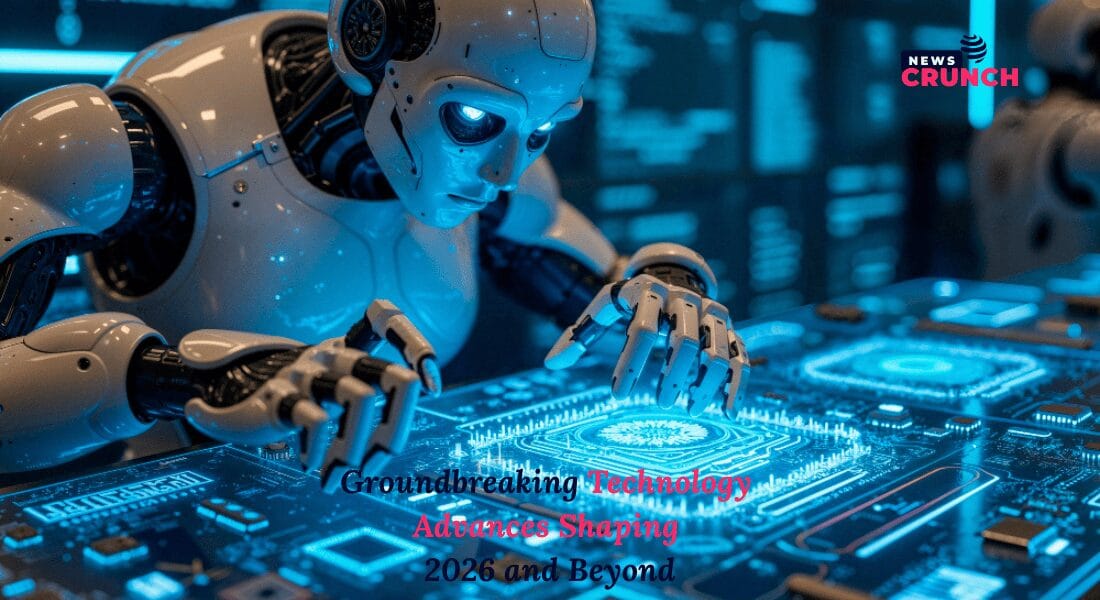Groundbreaking Technology Advances Shaping 2026 and Beyond
Technology Advances Shaping 2026
Introduction: The Future of Technology in 2026
2025 was already remarkable for innovation, but 2026 promises to be even more transformative. With rapid digital transformation and the continuous rise of emerging technologies, industries across the globe are preparing for a future where machines and humans will work closer than ever before. The shift is not just about convenience but changing how we think, live, and work.
What makes 2026 particularly exciting is the acceleration of fields like artificial intelligence, quantum computing, robotics, and materials science. These technologies are no longer futuristic concepts but practical solutions shaping our reality. They bring immense opportunities but also challenges—forcing us to rethink jobs, ethics, and even the meaning of intelligence itself.
2025 was already remarkable for innovation, but 2026 promises to be even more transformative. With rapid digital transformation and the continuous rise of emerging technologies, industries across the globe are preparing for a future where machines and humans will work closer than ever before. For those looking to understand how mobile platforms will shape 2026, check out the Ultimate 2026 Guide to Mobile App Development.
Artificial Intelligence: The Next Wave of Human-Machine Evolution
Artificial intelligence (AI) has become essential to modern life, powering everything from customer service chatbots to advanced healthcare diagnostics. 2026 AI is expected to push boundaries further with more powerful machine learning and natural language processing (NLP) tools. Unlike the early days when AI was confined to automation, it now plays a critical role in decision-making, predictive analytics, and real-time problem-solving.
The brain-computer interface (BCI) is the most groundbreaking area where scientists experiment with devices that connect directly to the human brain. With neuromorphic chips and advanced brain mapping, AI may soon expand human memory and learning capacities. Imagine accessing unlimited cloud knowledge through thought alone—this could transform education, healthcare, and even daily communication. Such possibilities make AI fascinating and a bit daunting, as it blurs the line between human and machine.
Cognitive Computing & Next-Gen Technologies
Cognitive computing is all about replicating human thought processes in machines. Breakthroughs like biological computing show that data could be stored in DNA instead of traditional silicon chips. These biocomputers have the potential to perform complex calculations within living cells, opening possibilities for medical and environmental applications that were once science fiction.
At the same time, other forms of computing, like photonic and optical computing, are pushing processing speeds to levels a million times faster than current systems. Add chemical computing, which mimics natural biological processes, and the arrival of quantum computing, and we see a future where computational power has no limits. This blend of classical and next-generation computing and AI could redefine the finance, cybersecurity, and biotechnology industries.
Robotics: Beyond Automation Towards Human-like Capabilities
Robotics has long been associated with automation in factories, warehouses, and agriculture. But in 2026, robotics will move beyond routine tasks into more intelligent, adaptive roles. Robots can perform functions in complex, unstructured environments using machine vision, AI, and advanced sensors. For example, drones can recognize and sort materials or robots that assist hospitals by learning patient needs in real-time.
A more futuristic development is the concept of self-healing robots, inspired by human-like resilience. Researchers are creating robots that can detect damage and repair themselves, which could revolutionize disaster management and space exploration. Imagine NASA robotics exploring deep space missions, surviving extreme temperatures, and assisting astronauts. The philosophical question, however, remains: as robots become more human-like, will they eventually replace us, or simply extend our abilities?
Advanced Materials Science: Stronger, Smarter, and Self-Healing
Materials science is another area quietly transforming our future. In 2026, scientists are designing stronger, lighter, and even self-repairing materials. Using nanotechnology and composite materials, industries such as construction and transportation can create bridges, roads, and buildings that adapt to weather, repair cracks, and last longer than ever before. This isn’t just innovation—it’s a sustainable approach that could reduce costs and improve safety.
One of the most exciting innovations is the development of “smart materials” that can adapt to their environment. For instance, polymers that change properties under stress, or self-assembling materials that can form new structures when needed. Coupled with AI-driven design, these materials may even be able to learn and evolve, giving rise to futuristic infrastructure that maintains itself with minimal human intervention.
3D Printing & Bioprinting: Redefining Manufacturing and Medicine
3D printing is already revolutionizing how products are manufactured, but 2026, it will reach new heights. Instead of traditional mass production, industries will rely on customized 3D printing for electronics, sensors, and even advanced circuits. This makes production faster, cost-effective, and tailored to consumer needs. With innovations like printed electronics, industries will soon be able to print chips, batteries, and displays directly onto thin surfaces.
Perhaps the most impactful development is bioprinting, where living cells are used to print human organs and tissues. This breakthrough offers hope to millions awaiting transplants, as researchers have already succeeded in creating kidneys, bladders, and even lungs in laboratories. If scaled successfully, bioprinting could eliminate organ shortages and revolutionize healthcare. Printing life-saving organs on demand is not only revolutionary—it’s life-changing.
| Technology | Key Features | Real-World Impact | Future Potential |
| Artificial Intelligence (AI) | Machine learning, NLP, Brain-Computer Interfaces | Smarter automation, personalized healthcare, adaptive learning | Human augmentation, sentient-like AI |
| Cognitive Computing | Biological, Photonic, Quantum, Chemical computing | Ultrafast data processing, DNA-powered storage | Next-gen computing intelligence |
| Robotics | Self-healing, adaptive, humanoid robotics | Industry automation, healthcare, exploration | Human-like collaborative robots |
| Materials Science | Nanotech, composites, self-healing materials | Stronger, sustainable, adaptive infrastructure | Smart cities & space materials |
| 3D Printing & Bioprinting | Printed electronics, organ bioprinting | Custom manufacturing, organ transplant solutions | On-demand life-saving healthcare |
The Techno-Fusion Era: Convergence of AI, Computing, Robotics, and Materials
The most fascinating part of 2026 technology is how these fields will merge. This “techno-fusion” means that AI will enhance quantum computing, robotics will benefit from materials science, and bioprinting will rely on intelligent design algorithms. The synergy of these innovations will multiply their impact, leading to unprecedented growth in industries from healthcare to aerospace.
For society, this convergence brings both opportunities and challenges. On one side, it promises breakthroughs in science, medicine, and sustainability. Conversely, it raises concerns about job replacement, ethics, and data security. Preparing for this fusion era means responsibly adapting policies, education, and industries to harness technology.
FAQs
Q1. What are the most important technology advances in 2026?
The key technology advances shaping 2026 include Artificial Intelligence, Cognitive Computing, Robotics, Advanced Materials Science, and 3D Bioprinting. These innovations are redefining industries and human life.
Q2. How will Artificial Intelligence impact our daily lives in 2026?
AI will go beyond automation, enabling brain-computer interfaces, more intelligent decision-making, personalized healthcare, and real-time learning systems that integrate deeply with human life.
Q3. What is cognitive computing, and why is it important?
Cognitive computing involves biological, photonic, quantum, and chemical computing. It offers faster data processing and new problem-solving capabilities beyond traditional silicon-based systems.
Q4. Can robotics really replace humans in the future?
Robotics in 2026 will move towards adaptive and self-healing robots, but rather than replacing humans, they will extend human capabilities in industries, healthcare, and space exploration.
Q5. What role does 3D bioprinting play in healthcare?
3D bioprinting is one of the most groundbreaking fields. It allows scientists to print human tissues and organs, potentially solving the global organ shortage crisis.
Q6. What is the “Techno-Fusion Era”?
The Techno-Fusion Era refers to the convergence of AI, robotics, advanced computing, and smart materials, which will create a powerful synergy that will reshape industries and societies.
Conclusion: Opportunities and Challenges in the Fourth Industrial Era
As we move deeper into the Fourth Industrial Revolution, the pace of change is faster than ever. From AI-driven brain interfaces to bioprinted organs, the future of 2026 will redefine how we live and interact with the world around us. These technologies won’t just support human progress; they may fundamentally alter what it means to be human.
Governments, businesses, and individuals struggle to strike the right balance between innovation and responsibility. If used wisely, the coming wave of technologies could make our societies healthier, more innovative, and more sustainable. The journey ahead may be unpredictable, but it is undoubtedly one of the most thrilling times in human history.






